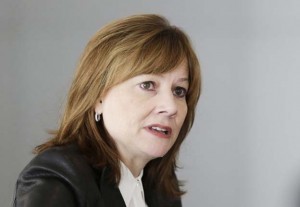
Embattled GM CEO Mary Barra defended the automaker's handling of the ignition switch recall in a speech today in New York.
General Motors’ Chief Executive Mary Barra today defended the automaker’s response in the wake of the recall of more than 2.6 million vehicles and her own handling of a safety-related problem that had festered inside GM for more than a decade.
Barra told a gathering an industry conference in New York City that GM has already taken several steps to replace ignition lock cylinders in the 2.6 million vehicles recalled to repair ignition switches. Parts are arriving at dealers, who have been enormously helpful in addressing the problem, she noted.
“Our actions in recent weeks show we at GM are committed to living our values. I am committed to seeing it through,” Barra said. “All of us understand what is at stake here.”
Barra also disclosed she was taking additional steps to insure future GM vehicles are safe.
“The new organization will build on the formula and specific actions we have taken in recent years to lead the industry in vehicle dynamics,” she said. “We will mirror this approach to focus on safety performance. Our goal is to ensure the highest levels of execution consistently across all our vehicles. The new organization will report directly to Mark Reuss, who leads Global Product Development, and include Jeff Boyer’s new safety organization.”
Barra said the new way of developing vehicles will provide the highest levels of safety, quality, and customer service… and ensure that a situation like the ignition-switch recall doesn’t happen again.
“In the last five years, we have made important and meaningful progress at GM in changing the company’s culture,” she said. “Our focus is no longer on survival. We are more focused on quality and doing what is right for the customer than at any time in my 33 years with the company.”
Earlier this week, Barra moved aside two executives with sensitive roles in facing the crisis as she determines a strategy for rebuilding the company’s reputation.
Barra replaced Melissa Howell, GM vice president of human resources, and Selim Bignol, GM vice president of communications. Howell was replaced by John Quattrone, who worked with Barra on human resource-related issues in recent years, as executive director of human resources for GM’s product development, purchasing and supply, where he was one of Barra’s direct reports before her elevation to the CEO job in January.
Quattrone is likely to play a significant role in resolving the ignition-switch controversy. Barra will rely on his office for advice about how to judge and discipline employees, who may have played a role in diverting attention from the faulty parts that have contributed to the death of 13 motorists, according to GM’s own studies.
(Toyota claims global small car sales supremacy over Ford. For more, Click Here.)
On the other hand, Barra did not name a replacement for Bignol, who was brought into GM from the telecommunications business by then-CEO Ed Whitacre. Whitacre worked with Bignol during his time at AT&T.
(Click Here to get details about the early returns on Chevy’s tie-up with Man United.)
She did not set a timetable for finding a replacement, which is somewhat curious. Traditionally, the vice president of communications at GM works closely with the company’s CEO in shaping the company’s image and message.
(To see more about the book honoring the pony car that almost wasn’t, Click Here.)
Whoever is named to that posted faces a difficult challenge since the recent recalls and the ignition switch controversy that set them in motion have undermined efforts to rebuild the company’s image.
GM also has disclosed it will take a $1.3 billion charge against first quarter earnings related to the recall. But the financial pressure – while significant – is only part of the challenge facing GM’s leadership. The company now must deal with multiple lawsuits and investigations into its inner workings that could take years to resolve.

Barra knew as well as all the rest of GM. She and all the top execs should be charged with murder. If not murder, then man slaughter. My days of buying GM cars are over.